Hi guys! I post here an interesting article that I found in historium.com, written by Salah a member of this forum that is an authentic expert of the Roman Empire in the "Third Century Crisis".
"The Gallic Empire" (by Salah): http://historum.com/ancient-history/...entury-ad.html
Roman Gaul
Gaul - corresponding with modern-day France, Belgium, Switzerland, and western Germany - was under a degree of both Roman and Carthaginian influence as early as the 3rd Century BC, but did not fall under Roman control until the conquests of Julius Caesar in the 50s BC. Revolts that appear to have been (loosely speaking) "patriotic" in nature were still taking place at least as late as the reign of Tiberius.
Gaul became outwardly Romanized fairly quickly- the process was already well underway before Caesar's conquests. The Celtic language, religion, and "spirit" of the native peoples remained discernable, and coexisted fairly well with those of the Romans. By the middle of the 1st Century Gaul was sufficiently "civilized" that Claudius passed a decree allowing Gaulish chieftains - most of whom now belonged to the Julii gens and bore Latin cognomens - to join the Senate. Many Gauls became prominent senators and military men in the Roman Empire; several emperors, including the Antonines, were of Gaulish stock.
From the reign of Vespasian to the reign of Marcus Aurelius Gaul and its inhabitants enjoyed a century of almost total peace. Save for some local and easily contained cases of brigandage, there was virtually no violence in the province. Its rich farmlands and vast population yielded large amounts of men and material to the Roman army. During the Marcomannic wars in the 170s AD, however, Gaul suffered. Germanic raiders penetrated the Roman limes as far south as Ravenna before being driven out by the Emperor. The late 2nd Century saw widespread strife in Gaul; a ugly mutiny organized by a soldier named Maternus is said to have taken place. Other parties of deserters and brigands haunted the roads and forests of Gaul, preying on travelers and plundering villas when they had the chance.
The violence in Gaul in the 2nd Century culminated in the Battle of Lugdunum in 198 AD, which decided the conflict between Septimius Severus and Clodius Albinus. Severus won this battle after only enormous loss of life on both sides; Lugdunum was one of the bloodiest battles in any Roman civil war. Severus did much to curb brigandage in both Gaul and Italy, and Gaul was again extremely quiet and prosperous in the Severan period. Severus' son, Antoninus "Caracalla" was proud of the Gaulish blood in his family's veins and associated himself heavily with this Celtic ancestry by wearing the Celtic garb that gave him his popular name. Accounts of Antoninus' life as well as contemporary tombstone carvings reveal that uniquely Celtic clothing not only existed in 3rd Century Gaul, but was as common as it had been in pre-Roman days.
The Origins of the "Gallic Empire"
First, I would like to point out what the Gallic Empire was not. The nature of the Gallic Empire has commonly been misrepresented; the first historical record to do so is certainly the Historia Augustae. The Gallic Empire was not in any way a resurgence of "Celtic" identity in Gaul, even if most of its inhabitants and emperors were of Gaulish Celtic extraction. The Gallic Empire was a thoroughly Roman entity; its emperors and most of its citizens were Latin-speaking Roman citizens. The fact that the Gallic Empire elected its own series of consuls, and used vexillations of Roman legions to form the vanguard of its armies and recruiting-pools for its officers is further evidence that the Gallic Empire was very much a "Roman" Empire.
The Gallic Empire, by definition, was a collection of Roman provinces that broke away from the Empire in and around 260 AD and organized themselves as a separate empire, under the guidance of the Roman general Postumus. The Gallic Empire remained strong for the duration of Postumus' life, but after his death in 268 or 269 AD it kept only a precarious hold on independence from the true Roman Empire. It was brought back into the Empire by Aurelian in 274, mainly as a result of Aurelian's sanguine victory at Campus Mauriacus.
Not unlike the contemporary Palmyrene Empire - another breakaway state in the Middle East - the Gallic Empire could be viewed as the most dire consequence of the incessant civil strife that plagued the Empire in the middle of the 3rd Century. Disgruntled provincials, sick of watching the soldiers butcher each other in the petty wars of emperors and usurpers, took their own defenses upon themselves. In the decade the the Gallic Empire was under the leadership of Postumus, Gaul won impressive victories over Franks and Alamanni, forged alliances with other Germanic peoples, and settled some peacefully in Gaul. The several years after Aurelian re-conquered Gaul, however, saw widespread destruction across the province at the hands of the Germanic peoples.
At its peak c. 265 AD, the Gallic Empire consisted of all of the Transalpine Gaulish provinces, both the Germaniae (Inferior and Superior), the Hispanic provinces, and the Britanniae. With the death of Postumus c. 268, Aquitania, Narbonensis, and possibly Spain all returned to the Roman Empire. Only the Germanic provinces, northern Gaul, and possibly Britain remained to the Gallic Empire of Tetricus in 274.
The Gallic Emperors
Postumus, 260 - 268/9 AD
Marcus Cassianus Latinius Postumus was the first Gallic Emperor, and the architect of the Gaulish independence. He is believed to have been a Batavian in ethnic origin - likely descended from a Roman auxiliary from Batavia. His date of birth is unknown, but he was probably at least in his 50s at the time of his death. No busts of him have survived, but his coins reveal a stoutly-built man with long, curly hair and prominent facial hair. Long hair and beards appear to have been the trademark feature of Gallic Emperors, in comparison to the short hair and clean-shaven looks favored by 3rd Century Roman emperors.
Postumus' early career is a mystery, but by c. 259/260 he was serving as the governor of Germania inferior on the Rhine. In 260 the Rhine frontier was left in his hands by Gallienus, who was setting out for the East. Among Postumus' colleagues in the Rhineland was Silvanus, Gallienus' Praetorian prefect, and Gallienus' young son Saloninus, both of whom resided at Colonia Aggrippina - Cologne. Valerian and Gallienus had pulled many precious legionary detachments away from the Rhine defenses, leaving the borders inadequately defended. Postumus, however, proved his skill as a commander by beating off large warbands of Alamanni and Franks. In response, his admiring soldiers and grateful provincials declared him emperor.
Postumus immediately besieged and took Cologne. Saloninus and his guardian were both put to the sword, and the city was sacked. This was in the same year that Valerian was captured by the Shapur I of Persia - Gallienus lost both his son and his father in a matter of a few months. Postumus decided not to pursue a claim to the entire Empire - his goal appears to have been the legitimate good of his province. It would perhaps not be too naive or romantic to view Postumus as a good soldier, defending his post with his life even at the expense of his allegiance to the rest of the troubled Empire - and its vengeful ruler.
Gallienus was incensed at Postumus' rebellion and invaded Gaul twice; he withdrew the first time after being defeated, the second time, after being wounded in a skirmish with Postumus' cavalry. Postumus, however, never launched an offensive campaign against Gallienus, nor did he seek any recognition in the Senate. His total lack of regard for Rome or the Senate was particularly disturbing - it revealed the possbility of the Empire breaking up beyond repair.
Postumus set about creating his very own Roman Empire. He used prominent citizens, military men, and Romanized chieftains to create a senate, and he used his favorite legionary vexillations to create his own Praetorian Guard. Just like Gallienus, he adopted a defense-in-depth police, creating forts all across the Rhineland and raising more cavalry units for quick response to Germanic incursions. Among his other deeds were adding to the fortifications of the cities of Germania and eastern Gaul, and minting a huge amount of coins bearing his portrait - many of which were superior in quality to those of Gallienus. Postumus waged at least one campaign east of the Rhine, inflicting painful defeats on the Alamanni. He appears to have bought the support of at least one Germanic tribe - the Thuringi, and recruited legionaries from their young men.
to those of Gallienus. Postumus waged at least one campaign east of the Rhine, inflicting painful defeats on the Alamanni. He appears to have bought the support of at least one Germanic tribe - the Thuringi, and recruited legionaries from their young men.
Postumus died late in 268 or early in 269 - shortly after the death of Gallienus and the ascension of Claudius in the main Empire. He perished in a manner not dissimilar to that of many other emperors in the 3rd Century. One of his officers, Gaius Ulpius Cornelius Laelianus, had attempted to make himself (Gallic) emperor, setting up his "capital" at Moguntiacum (Mainz). Postumus put down the revolt with ease and killed Laelianus, but did not allow his soldiers to plunder Moguntiacum. In response, the soldiers killed Postumus and sacked the city anyways.
Marius, c. 268/269 AD
Of all the figures to claim the purple in the 3rd Century, Marius is possibly the most poorly known. Virtually all that is known about this man - outside of bogus stories from the Historia Augustae - is his name, and that he suceeded Postumus for only a few months. His full name was Marcus Aurelius Marius, indicating that his family was provincial in origin and had received citizenship between the reigns of Marcus Aurelius and Caracalla (161-217 AD). The HA claims that Marius was elected on account of his name in the aftermath of the capture of Moguntiacum. A few months later he was supposedly murdered by a former employee, and was succeeded by Victorinus. Marius appears to have been the weakest - or at least the luckless - of the Gallic Emperors. From here the breakaway empire would only decline.
Victorinus, c. 269 - 271 AD
Marcus Piavonius Victorinus was probably of Gaulish stock. He was middle aged in the 260s AD, when he appears to have become one of Postumus' favorite generals. Virtually nothing is known of his reign except that not all of the provinces that had been ruled by Postumus would accept him. Victorinus probably lost much of Gaul and all of Spain to Emperor Claudius. He fought hard for his domination of central Gaul. The Aedui - who remained a numerous and prominent people in the 3rd Century - refused to recognize Victorinus and begged Claudius to send soldiers to bring them back into the Empire. Claudius could not or would not respond to their pleas, but in their main city of Augustodunum, the Aedui held out against Victorinus for the better part of a year. Victorinus took and destroyed Augustodunum in 270, only to die in the spring of 271. Nothing is known of his deeds or personal life; the Germanic tribes were unable or unwilling to enter Gaul during his reign, suggesting that the Rhine frontier remained stable under Victorinus.
Tetricus 271 - 274 AD
Gaius Esuvius Tetricus was chosen to lead the Gallic Empire after the death of Victorinus at the beginning of 271 AD; supposedly he had been chosen by Victorinus' powerful mother Victoria. Victoria appears to have held a smidge of Imperial power early in 271 - she was one of several Roman women in the 3rd Century to unofficially control part of the Empire in the absence or death of her husband/son. Nothing is known about Tetricus before he became emperor, but his nomen Esuvius suggests strong Celtic origins. His coins show a handsome and fairly young man with a shorter beard than his predecessors, and long straight hair.
The Gallic Empire was already decaying when Tetricus ascended, though he managed to inflict defeats on the Franks and Alamanni. In 274 AD, Lucius Domitius Aurelianus was ruling a unified Roman Empire, and was determined to bring the Gallic province back into the fold. He accomplished this goal in the summer of that year, when he defeated Tetricus and the cream of the Gallic legions at Campus Mauriacus. Tetricus and his young son and co-ruler by the same name were displayed in Aurelian's triumph in Rome, but were spared. Tetricus apparently enjoyed a prosperous public career in southern Italy long after his defeat. Tetricus was the last Gallic emperor, and Gaul, Britain, and Roman Germany were firmly under Roman control for the rest of the 3rd Century.
The Fall and Legacy of the Gallic Empire
The defeat at Campus Mauriacus was a victory that had every appearance of a defeat. Thousands of veteran legionaries - good fighting men, a precious commodity in Aurelian's time - were killed or crippled. These losses crippled the Rhine defenses, which were broken by successive waves of Franks, Alamanni, and Saxons during the 270s and 280s. This period saw unprecedented destruction in Roman Gaul and Germania; Colonia Agrippina, once the capital of the Gallic Empire, was looted. Most other Roman forts and colonies in Germania were burned to the ground; Roman soldiers and civilians were butchered and buried in mass graves at at least site. Germanic raiders pillaged as far south and west as the territory of the Remi and Parisii, well into Gaul.
With Postumus' defense-in-depth policy, the Rhine frontier had been very stable under the Gallic Empire, and western Europe enjoyed a measure of peace - even a short golden age of sorts - while the Danube provinces and the rest of the Roman world suffered enormously. Aurelian had both the time and resources to bring Gaul back into the Empire; it would have been a slap in his face if he had let their indepedence persist. The rebirth of a united Roman Empire, however, was heralded by the virtual destruction of the Roman presence in Germania.
The Gallic Empire above all else how thoroughly Romanized a culture could become. By descent, virtually all of its free inhabitants were Celts or Germans, and Gaulish was still widely spoken. Nonetheless, in the fourteen years of its independence Gaul was ruled by an "Imperator Caesar Augustus" who appointed consuls, met with a senate, and was protected by his own Praetorian cohorts.
Even in the most dismal of military and strategic situations, Roman law and culture proved resilient. The Gallic Emperors never even tried to bring Rome or Italy into their Empire, or gain the recognition of the "real" Senate - but they thought of themselves not as Gauls, but as Romans.
Proppossal about the Praetorian Guard and the Heavy Cavalry of Gallienus:
So, in light to the refference of the text about a praetorian guard of the gaullish emperors I think that could be interesting if the Gallic Empire faction would have a praetorian guard different from the praetonians of the formal Roman Empire. This "Gaullish Praetonians" could have a simmilar look at the "official" praetorians but with some own characteristics, as that the soldiers would have "torcs" and long moustaches and beards, in concordance with thier gaullish origin (and following the look of their proper emperor.)
Here I put some pictures of miniatures of the Praetonian Guard (that could be used as inspiration for the praetonians of the Gallic Empire) and of Heavy Roman Cavalry as the used by Gallienus and his successors:
Imperial Roman Praetorian Inner Guard Cohort:
Source: http://raglansimperialromanwars.blog...1_archive.html
Heavy Roman Cavalry:
Source:http://sisolders.wordpress.com/page/19/
to those of Gallienus. Postumus waged at least one campaign east of the Rhine, inflicting painful defeats on the Alamanni. He appears to have bought the support of at least one Germanic tribe - the Thuringi, and recruited legionaries from their young men.





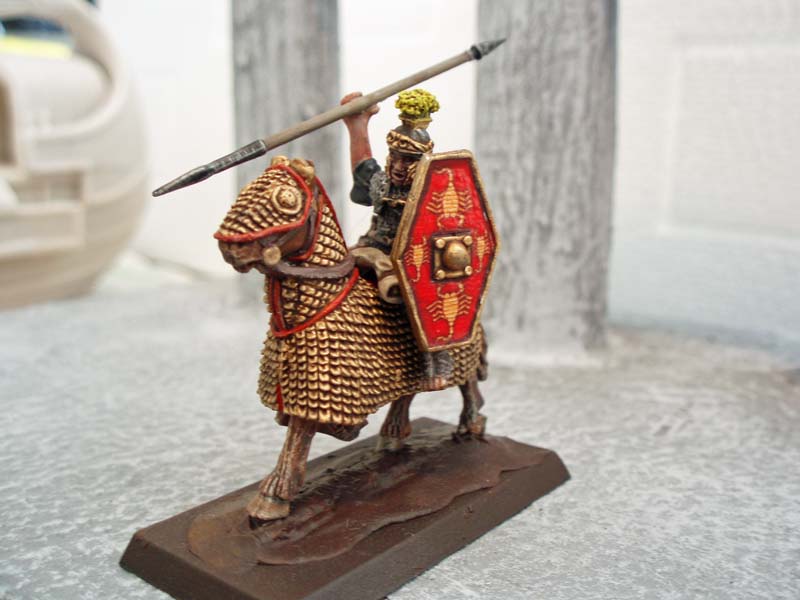
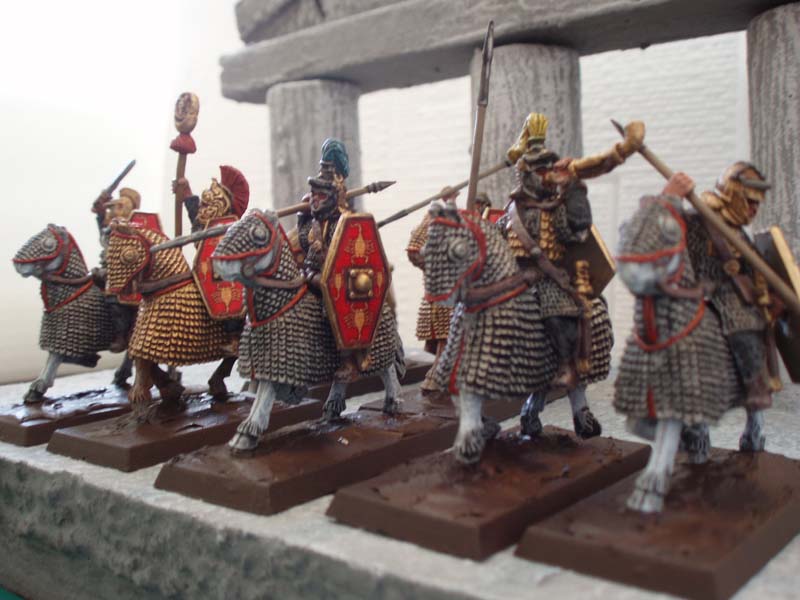
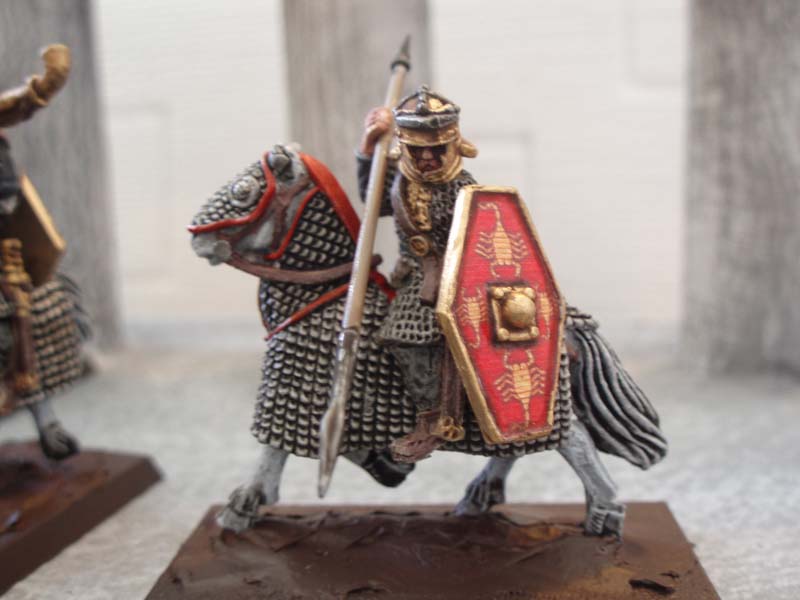
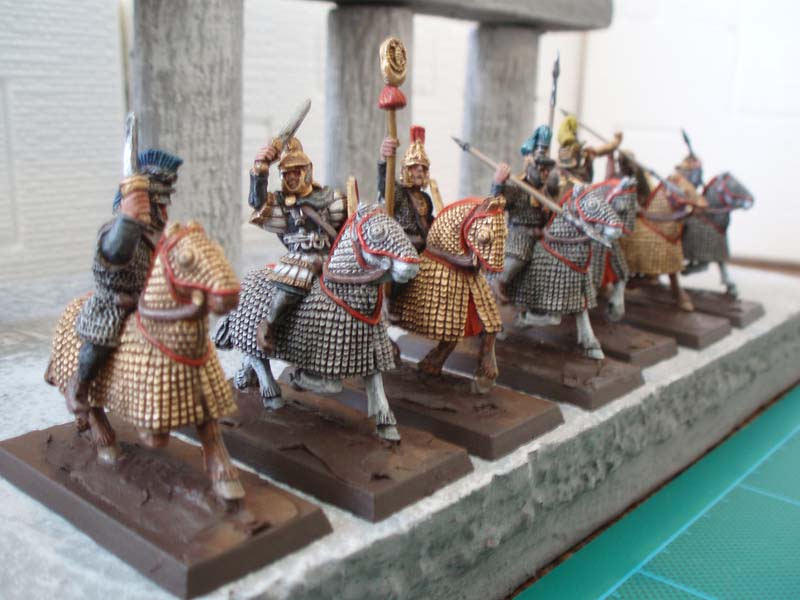
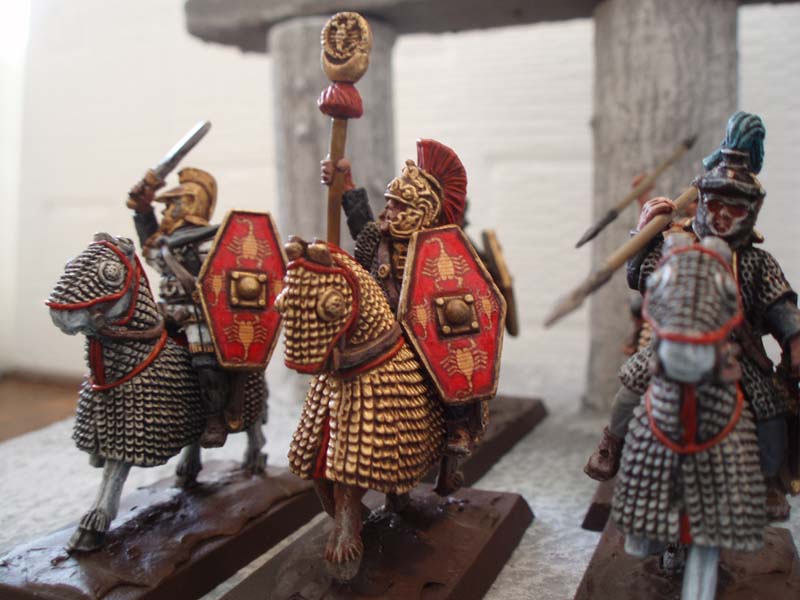
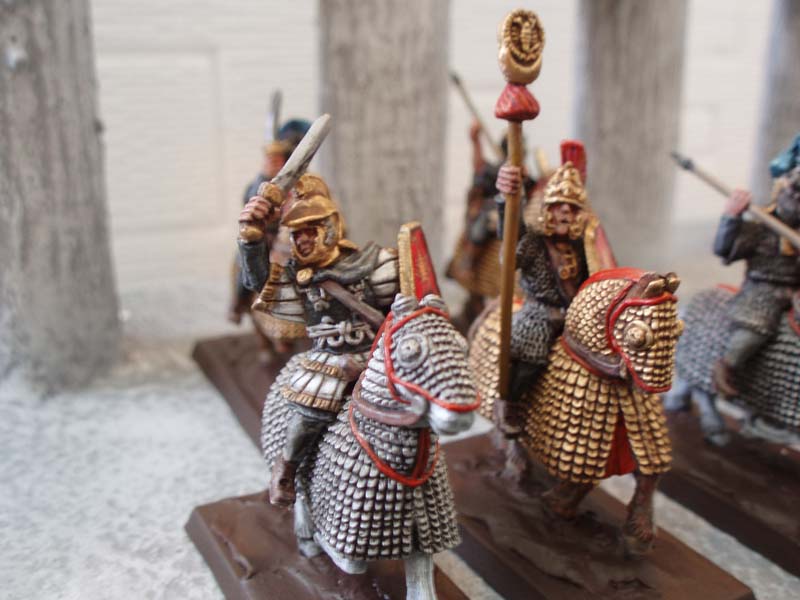



 Reply With Quote
Reply With Quote









